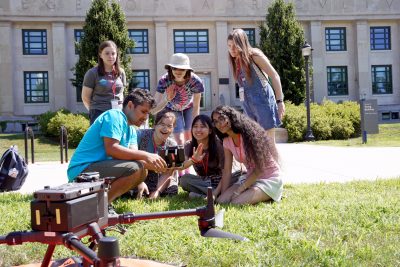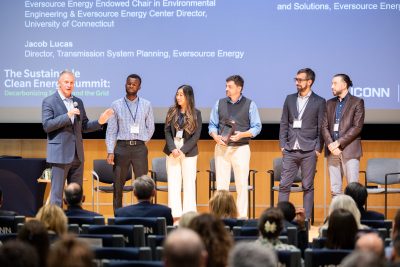How We Work
The Institute of the Environment and Energy (IoEE) at UConn brings together the expertise and passion of scientists and scholars across the University to address some of the most pressing challenges and grandest opportunities facing society in the 21st century.
Our Mission
To discover, develop, engage, and enact socio-technical solutions to enhance the social, economic, cultural, and natural environments and secure the energy system of Connecticut and beyond.
The work of IoEE starts internally, through collaborations with the University’s operational units to ensure that our institutional commitments to sustainability and green infrastructure are essential values that guide decision-making. Administratively, IoEE currently comprises more than 170 faculty members and includes five administrative units: the Center for Environmental Sciences & Engineering (CESE), the Eversource Energy Center (EEC), the Natural Resources Conservation Academy (NRCA), the New England Thriving Communities Technical Assistance Center (TCTAC), and the Office of Sustainability (OS).


The IoEE works to advance foundational understanding and develop innovative solutions to pressing environmental challenges, to prepare the next generation as adept and agile members of a 21st century workforce, and to inform and engage the public about what are arguably the existential issues of our time. Solving environmental problems related to climate change, sustainability, food security, pollution, and species extinction requires an interdisciplinary approach that leverages expertise from diverse disciplines across the natural sciences, social sciences, and humanities. It requires consideration of multiple angles, from biophysical to cultural, and from legal to health perspectives.
Our Focus Areas

Research
The Institute of the Environment and Energy (IoEE) brings together UConn’s world-class faculty and cutting-edge research facilities to deliver integrated, ground-breaking solutions to the urgent challenges of rapidly-changing environmental conditions and the transition to a sustainable, secure energy system. IoEE partners with communities, industry, and government to turn innovation into action, from problem identification to solution implementation.

Education

Engagement
The Institute's outreach activities connect communities, industry, government, and non-profit partners to address pressing environmental and energy challenges with the latest scientific advancements. Through early and sustained stakeholder engagement we ensure that solutions are responsive, inclusive, and grounded in real-world impact.